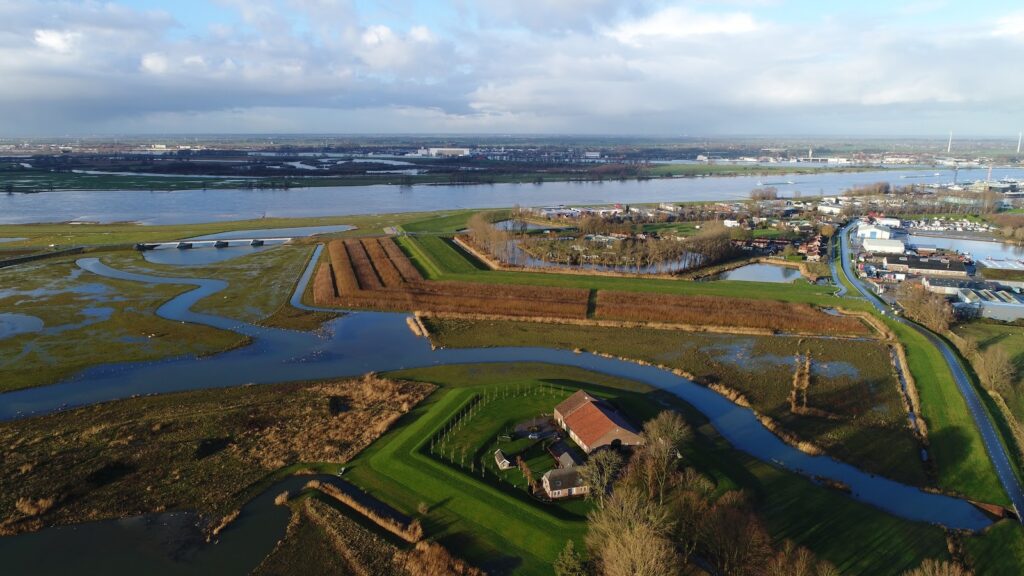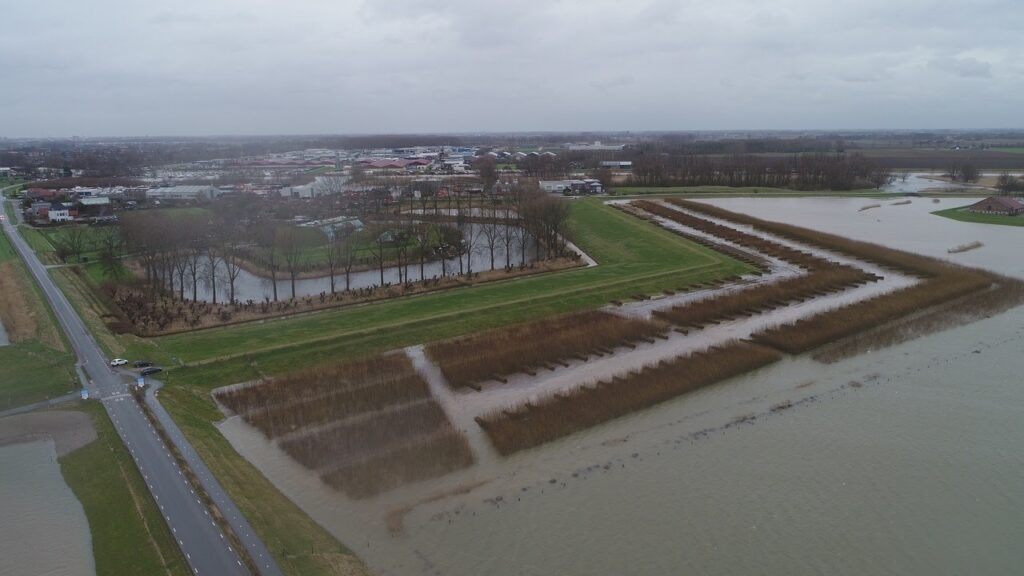Adaptive management, monitoring and maintenance: Wave attenuating willows
Within the Room for the River program, the polder Noordwaard functions as an extra river branch of the Nieuwe Merwede river at times of high discharge. With this new function, the levee that previously functioned as a secondary levee is now the primary levee. Plans to heighten this levee were poorly viewed by the local population. Therefore, the aim shifted from a traditional design towards a Building with Nature design that omitted the otherwise required levee heightening. Alternatives were explored for a design that utilized the wave-reducing effect of vegetation, as wave reduction would lead to a significant reduction of required total dike height. The final design consists of a willow tree forest in front of the dike, which has a 0.7m lower crest than a traditional design with a similar flood protection level.
Here, we address natural, technical and social uncertainties that played a role this particular Building with Nature project and show how the project team addressed these matters throughout the project.

Natural uncertainties
Sustainability of willow trees (short-term and long-term)
Including trees in a flood protection scheme requires assurance that the trees will be there once a storm hits. However, the health and presence of willows can be influenced by various unpredictable events such as: diseases, biological plagues, beaver damage, drought, frost, fire, overgrown, tree die-off (life cycle ~35 years), extensive inundation duration, erosion of the foreland. Some of these events occur rather rapidly, e.g. fire, while others occur relatively slowly, such as tree die-off. During the design phase critical events were identified and an adaptive maintenance strategy was set-up that prescribed (1) what should be monitored and when, (2) the signal values (e.g. minimum green belt width) for making an intervention, and (3) the actions that should be taken if critical signal values are exceeded. The project uncertainties that originated from unpredictability were tackled by an adaptive management strategy that was executed after the implementation phase. In addition, a mowing and cutting plan was put in place to assure overall health of the willow forest.
Technical uncertainties
Performance under extreme hydraulic loading
The performance of the solution, especially the interaction between willows and waves was unknown. These technical uncertainties originated from imperfect knowledge and were tackled by estimating performance under extreme hydraulic loading based on the best available knowledge and by applying a conservative design. A critical question was for instance: what tree coverage (green belt width, density, height) is needed to dampen the incoming waves to an acceptable degree such that wave attack on the levee is limited?
During the initiation phase of the project, a proof of concept was made for the wave attenuating effect of vegetated foreshore. This proof-of-concept was supported by numerical wave-vegetation simulations based on best available knowledge. The numerical simulations were performed with a newly developed vegetation module of the numerical wave model SWAN based on laboratory research. The results led to further exploration of design alternatives with vegetated foreshores.
During the design phase the required forest density and width were assessed, using more detailed computations that accounted for the potential angle of wave attack and forest characteristics. Results indicated that an effective forest width between 12-40 meters would lead to a crest height reduction of over 0.5 m for 1/2000 years design conditions. More conservative results were used as input for the final design of the willow forest, to deal with uncertainties in wave-vegetation interaction during situations of extreme hydraulic loading (a robust strategy).
During the implementation phase the willow tree forest was planted with a width between 60-90 meters, thereby exceeded the theoretical required width. This conservative design width is a robust approach to handling uncertainty, allowing maintenance once every two years while the safety standards will be met at all times.

Social uncertainties
Regulations
A key source of uncertainty in the social system was the absence of rules to test the implementation of a willow forest as part of a dike design in current safety assessment methods (known as VTV). To ensure that the eco-friendly dike could be tested for safety, Venema et al., (2013) designed a testing scheme providing guidelines on testing, monitoring and maintenance of the dike. This new safety testing scheme has been approved by ENW-Techniek, the national Expert group for Water Safety in the Netherlands and could possibly serve as a basis for the implementation of such innovative designs into the VTV. In order to get a fully accepted innovative design, relevant testing steps for vegetation as integral part of a dike will have to be designed and included into future releases of the VTV.
Local situation and perception
People living in the fort did not want a high dike in front of their house (opposition against traditional levee design with armoured concrete layer). Already at the start of the project these house owners became an important stakeholder group to be included. They had an active role in the design phase and helped steering the focus away from a traditional levee design. During high discharge events the Noordwaard polder might be inundated. Local farmers disliked this fact as it prevents continuation of their work.
References
Venema, Johannes E., Schelfhout, Harry A. and Van der Meulen, Myra D., 2013. Toetsmethode grienddijk Fort Steurgat, hoofdrapport en achtergrondrapport, Deltares report 1206002-000 (in Dutch)
